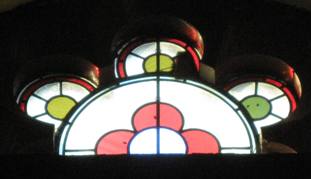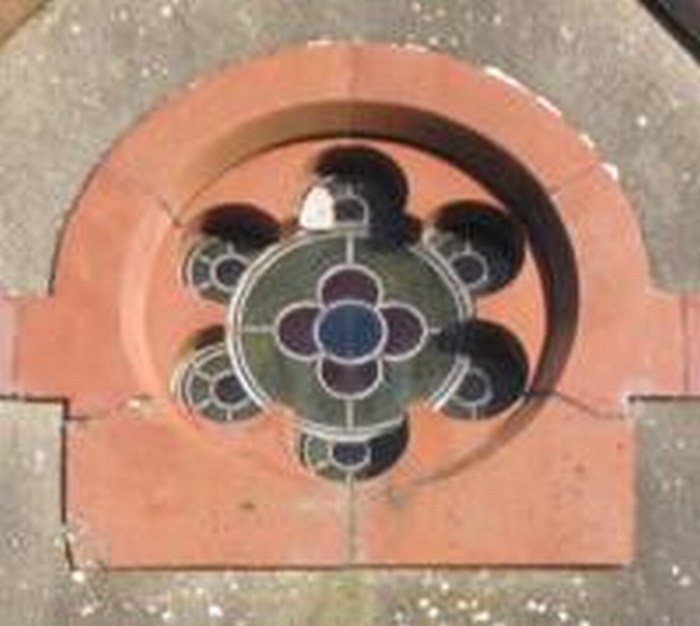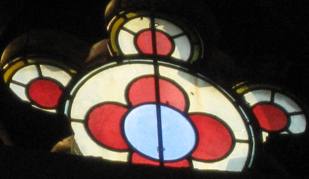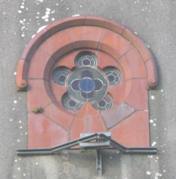Fenor: Church Windows Album
- Fenor Church Windows
- Fenor Church Windows
- Fenor Church Windows
- Fenor Church Windows

There are three windows in the west gable – the Phoenix window and the Chi Rho Boat window above the main door, and a small window in the peak of the gable. The images below are of the peak window, viewed from inside and outside the church. The view from the inside is partially obscured by the roof woodwork and by the masonry surrounding it.


This is the biggest of the four peak windows because of its prominent position above the main door.
In the south transept there are seven windows including a small window, shown below, in the peak of the gable. The other six windows will be shown in a west to east (right to left) direction, numbering them 1 to 6, respectively. They may be accessed from the menu at top left.


This is the window in the peak of the gable. As with the other peak windows, it cannot be photographed properly without the aid of a ladder or a brontosaurus.
This window, too, is partially hidden by its masonry surround. It is identical to the peak window in the north transept. The view from the outside shows a bracket that was once used to support an aerial.
This window is slightly obscured on the left by a loudspeaker.
The window detail shows rosary beads and a crown.
The crown refers to Mary, the mother of Jesus, who is “Queen of Heaven”. The rosary is a five-decade rosary which has five sets (decades) of ten beads with an additional large bead before each decade and after the last decade. Such beads are normally used to say five mysteries of the rosary (five Joyful Mysteries or five Sorrowful Mysteries or five Glorious Mysteries). Beads used by religious orders often have fifteen decades for saying all fifteen mysteries. Rosary beads of various types have been in use since the 12th century.
On October 16 2002, Pope John Paul II declared that the following year would be the “Year of the Rosary”. The Pope added and defined five new mysteries that concerned events in the public life of Jesus. These new mysteries were called the “Luminous Mysteries” or “Mysteries of Light”.
We are unsure as to exactly what this window detail is showing. It could be a small casket or a large chest. It doesn’t look like an altar. Could it be the Ark of the Covenant? –
“They shall make an ark of acacia wood. Two cubits and a half shall be its length [a cubit was about 18 inches or 45 centimetres], a cubit and a half its breadth, and a cubit and a half its height. You shall overlay it with pure gold, inside and outside shall you overlay it, and you shall make on it a moulding of gold around it. You shall cast four rings of gold for it and put them on its four feet, two rings on the one side of it, and two rings on the other side of it. You shall make poles of acacia wood and overlay them with gold. And you shall put the poles into the rings on the sides of the ark to carry the ark by them. The poles shall remain in the rings of the ark; they shall not be taken from it. And you shall put into the ark the testimony that I shall give you [the two stone tablets bearing the ten commandments].
“You shall make a mercy seat of pure gold. Two cubits and a half shall be its length, and a cubit and a half its breadth. And you shall make two cherubim of gold; of hammered work shall you make them, on the two ends of the mercy seat. Make one cherub on the one end, and one cherub on the other end. Of one piece with the mercy seat shall you make the cherubim on its two ends. The cherubim shall spread out their wings above, overshadowing the mercy seat with their wings, their faces one to another; toward the mercy seat shall the faces of the cherubim be. And you shall put the mercy seat on the top of the ark, and in the ark you shall put the testimony that I shall give you. There I will meet with you, and from above the mercy seat, from between the two cherubim that are on the ark of the testimony, I will speak with you about all that I will give you in commandment for the people of Israel”. [Exodus 25:10-22].
The window detail is grey in colour instead of golden, has no rings or poles, no feet, and no mercy seat or cherubim. So it’s unlikely to represent the Ark. (See also the sixth south transept window).
A looking glass or mirror is the subject of this window. Why a mirror? What do you see when you look into a hand mirror? Principally, you see yourself, warts and all – just as others see you.
“O wad some Power the giftie gie us
To see oursels as ithers see us!
It wad frae monie a blunder free us,
An’ foolish notion:
What airs in dress an’ gait wad lea’e us,
An’ ev’n devotion!”
[Robert Burns, “To a Louse” – verse 8]
There are six windows in the nave and we will number them 1 to 6. Windows 1 to 3 are in the north wall of the nave (the left side of the church when facing the altar) with number 1 nearest to the altar and number 3 next to the porch door.
Windows 4 to 6 are in the south wall (the right side of the church when facing the altar) with number 4 next to the porch door and number 6 nearest to the altar. If you stand in the nave facing the altar and then turn left a full circle, you will see the windows in the order 1 to 6.

The windows all have the same decorative features but in different colours.
Each window has a different main detail. They say, “The devil is in the detail”.
This window is situated under the gallery and it is impossible to photograph all of the window in a single photograph which is why the top of the window appears to be missing.
The window shows a pair of lighted candles, a sandglass, and a third object which we are unable to identify but which may be an extinguished oil lamp. All of these signify the transience of human existence –
“And all our yesterdays have lighted fools
The way to dusty death. Out, out, brief candle!
Life’s but a walking shadow …” [Macbeth Act 5, scene 5].
In this window, the chalice and the host (consecrated bread) represent the Eucharist (Holy Communion).
The Latin word calix means cup and hostia is Latin for victim –
“For I received from the Lord what I also delivered to you, that the Lord Jesus on the night when he was betrayed took bread, and when he had given thanks, he broke it, and said, ‘This is my body which is for you. Do this in remembrance of me.’ In the same way also he took the cup, after supper, saying, ‘This cup is the new covenant in my blood. Do this, as often as you drink it, in remembrance of me.'” [1 Corinthians 11:23-25].
The letters IHS on the host are the first three letters of the Greek name for Jesus (see HERE for an explanation).
This window is slightly obscured by a loudspeaker on the right side.
The handshake, or grip, is a sign of friendship, unity, oneness of purpose and allegiance or devotion to a joint cause. The right hand in particular is an emblem of friendship, and the window detail shows two right hands.
The stole that is wrapped around the two hands is a priestly garment that symbolizes the bonds and fetters with which Jesus was bound during his Passion; it is usually ornamented with crosses, as in this case. The stole and handshake together particularly emphasise the bond of friendship.
The letters I, H, and S are the first three letters of the Greek name for Jesus (see HERE for an explanation).